In 1881, the Squaxin of the Puget Sound area in Washington would have described John Slocum has having a bit of an inclination toward alcohol and a well-known fondness for gambling. One day he became ill and died. Upon dying, he went to heaven where he was met by angels who told him that because he had been bad on earth he could not enter Heaven. He was then given a choice of going to hell or returning to life to preach to Indians about the way to enter heaven.
School superintendent Edwin Chalcraft, in his book Assimilation’s Agent: My Life as a Superintendent in the Indian Boarding School System, reports:
“In the middle of the afternoon, he again resumed life, and got up from where he was lying and ran off a short distance to some people and began talking to them.”
When he came back to life, he returned with a divine mission to fulfill among his people. Upon his return to life he begins to preach against alcohol, gambling, and other “Boston” vices.
Slocum’s new religion was strongly opposed by the Indian Agent, Edwin Eells who told the Indians to accept the Christian missionary’s guidance. Anthropologist Thomas Buckley, in an article in the American Indian Quarterly, reports:
“Slocum’s experience was coherent with the Prophet Dance pattern of coastal Washington and the Plateau, and it also showed the considerable influence of both Protestant and Catholic missions in the Puget Sound area.”
However, Slocum’s experience was coherent with the pattern of the traditional Prophet Dance found among the tribes of coastal Washington and the Plateau area. The new religion also incorporates some Christian concepts due to the influence of the Protestant and Catholic missions in the Puget Sound area.
The focus of the new religion, as in the traditional Indian religions of the area, was on curing. In the curing ceremonies, practitioners would enter a trance state at which time the Spirit of God would come over them. Filled with this Spirit they would shake and the shaking represented the gift of curing. Hence the new religious movement was soon dubbed the Shakers, or, more formally, the Indian Shaker Church.
According to anthropologist Pamela Amoss, in her entry on the Indian Shaker Church in the Handbook of North American Indians:
“Like the old guardian spirits, the Shaker Spirit comes to a person in a trance experience but is always present in a less obvious form.”
In her entry on the Puget Sound tribes in the Encyclopedia of North American Indians, Alexandra Harmon reports:
“Their conviction that the holy spirit gave individuals the power to heal was a syncretic fusion of Christian and aboriginal beliefs.”
The major growth in the new religion came about in 1883. John Slocum again became ill and his relatives, fearing that he was about to die, called in a traditional healer. His wife, Mary, left the house in protest. Mary was then overcome by an uncontrollable shaking and re-entered the house to pray over her husband. John Slocum recovered and Mary’s shaking was hailed as medicine from God. This event marks the beginning of an explosive growth in the new movement.
The Indian Shaker Church diffused among the different tribes of the Puget Sound area. Curing ceremonies were frequently held and the Shaker Church often became important in the social life of the people. The Shaker Church was usually a rectangular wooden structure with a modest bell tower. The Shaker rituals are accompanied by the ringing of bells, singing, and stomping. In his book When the River Ran Wild! Indian Traditions on the Mid-Columbia and the Warm Springs Reservation, George Aguilar writes:
“Shaker bellringers would stomp on the wood floors with leather-heeled boots to make as much noise as possible. This was called kicking the floor.”
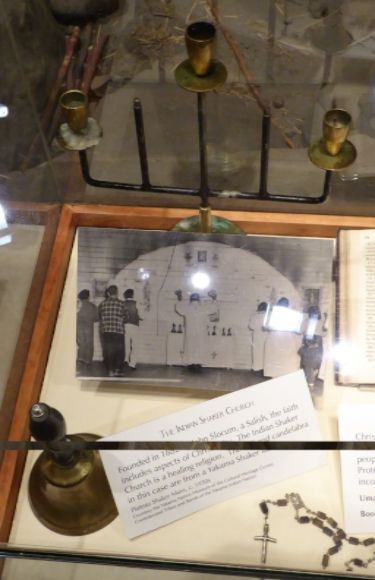 The bell and the candelabra shown above are important in the Indian Shaker Church. This display is in the High Desert Museum in Bend, Oregon.
The bell and the candelabra shown above are important in the Indian Shaker Church. This display is in the High Desert Museum in Bend, Oregon.  Shown above is a sign displayed at the Wasco County Historical Museum in The Dalles, Oregon.
Shown above is a sign displayed at the Wasco County Historical Museum in The Dalles, Oregon.
The Indian Shakers founded the Lone Pine Shaker Church near The Dalles. According to the Wasco County Historical Museum display:
“Unlike the Christian missions, they did not insist on precise beliefs or practices. The Indian Shaker faith drew upon both Indian religions and Christianity. It touched the lives of thousands and survives in a number of native communities.”
The American government opposed the Indian Shaker Church, with government officials disrupting meetings and arresting the participants. In 1887, for example, the members of the Chehalis Indian Shaker Church met at the home of George Walker to doctor Puyallup Bill. Puyallup Bill had been spitting blood for a month or two and had come from the Puyallup reservation so that he could be doctored by the Shakers. The healing ceremony was discovered by school superintendent Edwin Chalcraft and consequently ten men were arrested. The leaders—John Smith, Peter Yo-kum, Thomas Heck, and George Walker—and the patient were sentenced to ten days of hard labor.
In 1885, a Skokomish man brought the Indian Shaker religion to the Jamestown S’Klallam when he was invited to cure Annie Newton, the wife of Billy Cook. L.L. Langness, in a chapter in Shadows of Our Ancestors: Readings in the History of Klallam-White Relations, reports:
“The Shaker meetings became very important in the social life of the people, and even many of those who were not active Shakers, including many of the younger people, attended the curing ceremonies which were held frequently.”
One of the most important features of the Shaker religion for the S’Klallam is curing. In addition, the Shakers also have the power to locate lost items. L. L. Langness reports:
“One man located horses regularly by shaking and then pointing out the direction where they were to be found.”
In 1887, members of the Chehalis Indian Shaker Church met at the home of George Walker to doctor Puyallup Bill. Puyallip Bill had been spitting blood for a month or two and had come from the Puyallup reservation so that he could be doctored by the Shakers. The healing ceremony was discovered by school superintendent Edwin Chalcraft and consequently ten men are arrested. The leaders—John Smith, Peter Yo-kum, Thomas Heck, and George Walker—and the patient were sentenced to ten days of hard labor. School superintendent Edwin Chalcraft would later write:
“The punishment of these five men did have a quieting effect on the Shakers at Chehalis.”
In 1891, a man drowned in the Yakima River and his body was not found. A member of the Indian Shaker Church set up a small altar, and accompanied by others who ring bells, he followed his shaking hands in an attempt to find the body. While the first attempt failed, the Shaker located the body on the second day.
In that same year, John Slocum, Mud Bay Louis, and several other Shakers traveled to the t Yakama Nation to cure a Wishram woman was is the sister-in-law of Alex Teio. Following the cure Alex Teio and several others converted to Indian Shakerism.
In 1892, the Indian Shakers held a meeting in public defiance of the Indian agent’s ban on their religion. They wished to affirm their freedom of religion. The meeting was disrupted by both Indian and non-Indian opponents, but attorney James Wickersham issued official looking documents affirming the Shakers’ right to practice their religion.
Edwin Chalcraft, an opponent of both the Shakers and Wickersham and a close friend of Indian Agent Edwin Eells, would later write:
“Wickersham was a bitter opponent of Agent Eells’ because the Agent had defeated him as attorney for land grabbing companies in their efforts to illegally get possession of Indian lands on the Puyallup Reservation.”
Wickersham then helped the Shakers organize their church into a legal corporation. Since a corporation is a person under American law, this makes the Church a person and as such gave it certain legal rights. With this action, the Indian Shaker Church became legally recognized and religious freedom was obtained.
Many Indian agents continued in their attempts to suppress the Indian Shaker Church. In 1884, for example, the Court of Indian Offenses on the Chehalis Reservation in Washington decided not to allow John Smith to attend a meeting of the Indian Shaker Church. Smith defied the order and attended anyway.
In 1897, John Slocum died. The religious movement that he started did not die with him, but continued to attract members.
Indians 101/201
This series explores different American Indian topics. The designation “201” indicates a revision and expansion of an earlier essay.
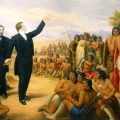
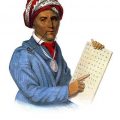
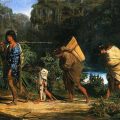
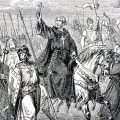
Leave a Reply